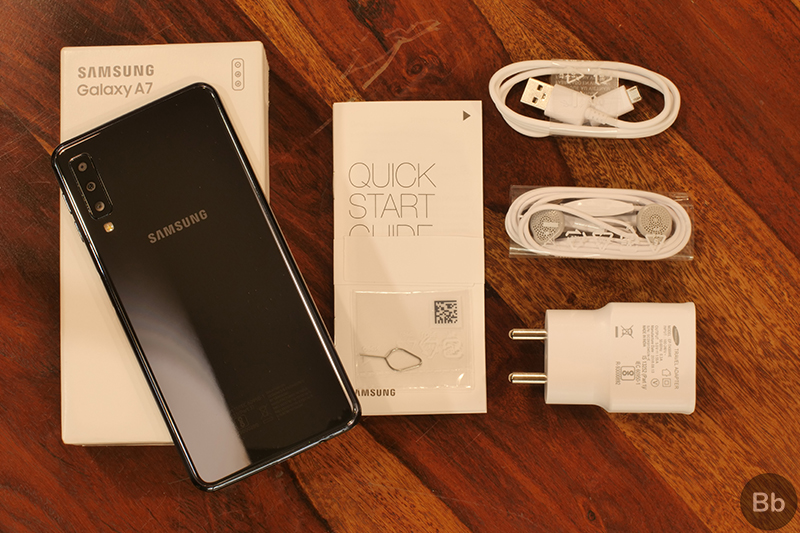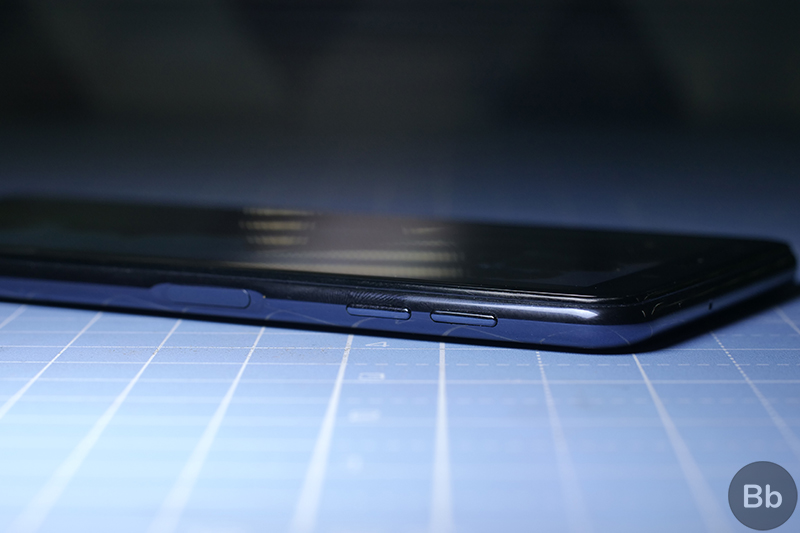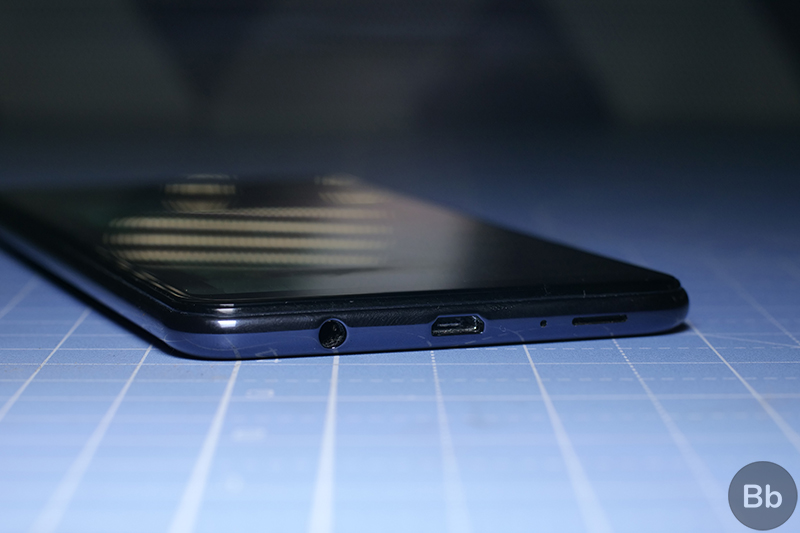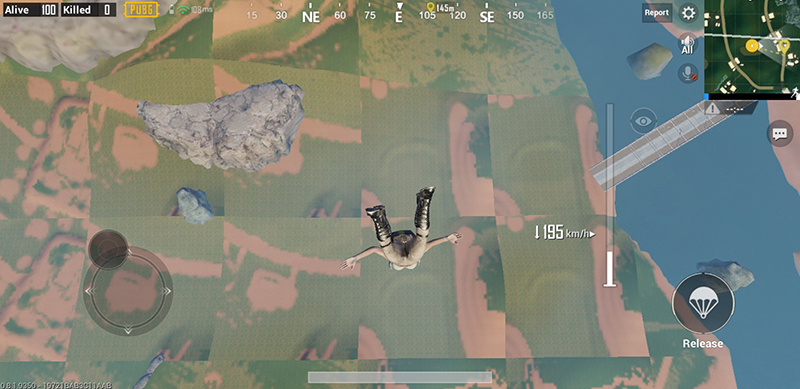Beebom Score
Of late, Samsung has been called out for releasing sub-par devices on several occasions since the beginning of the year. The company has been releasing Snapdragon 450 powered mid-range devices one after the other and despite the fact that these devices bring some premium features, the company just hasn’t been able to justify their price tags. With the recent launch of the new Galaxy A7 (Rs. 23,990), Samsung aims to recapture the mid-range market which is currently being dominated by Chinese smartphone manufacturers.
The new Galaxy A7, unlike its predecessors, is powered by an Exynos 7885 SoC – one of Samsung’s own processors that lies somewhere between the Snapdragon 636 and the Snapdragon 660 in terms of performance. Along with the new processor, the smartphone packs in 4/6GB of RAM and 64/128GB of internal storage with a dedicated microSD card slot that supports up to 512GB cards. Here, we’ll be taking at close look at the Samsung Galaxy A7 to find out if the smartphone is worth the money and whether Samsung has actually been paying any attention to the growing competition in the mid-range price segment.
Samsung Galaxy A7 Specifications
The new Samsung Galaxy A7 is a premium mid-ranger that packs in some impressive hardware for the price. So before we get on any further with the review, let’s take a look at the complete hardware specifications of the device:
| Display | 6-inch FHD+ Super AMOLED |
| Processor | Exynos 7885 |
| RAM | 4/6GB |
| Storage | 64/128GB |
| Primary Cameras | 24MP f/1.7 + 8MP f/2.4 (ultra wide) + 5MP f/2.2 |
| Secondary Camera | 24MP f/2.0 |
| Battery | 3,300mAh |
| Operating System | Samsung Experience 9.0 based on Android 8.0 Oreo |
| Price | Starts at Rs. 23,990 |
What’s In the Box
The Samsung Galaxy A7 comes in a standard white box that the company reserves for its mid-range devices. The box doesn’t feature the device on the outside and just states A7 Triple Camera up front, with more information about the device on the back.

Here’s everything you’ll get within Galaxy A7’s retail packaging:
- Samsung Galaxy A7 smartphone
- 5V/1.55A charging brick
- USB Type-A to microUSB cable
- Earphones
- SIM ejector tool
- Paperwork
Design and Build Quality
Beginning with the aspect of the Galaxy A7 that you’re bound to notice before everything else, its design. The new Galaxy A7 takes a departure from Samsung’s tried and tested design for its mid-range smartphones and does things a bit differently. The device has very premium all-glass design with Gorilla Glass 3 protection on the front and back. The Galaxy A7 is a bit more boxy, compared to previous A-series devices, and it’s great to hold in the hand thanks to its 2.5D curved glass coupled with its 7.5mm thin form factor. The device feels very premium in the hand and I personally like this design more than the design of previous Samsung mid-rangers.

Up front, the Galaxy A7 features an impressive 6-inch FHD+ Super AMOLED Infinity display with an 18.5:9 aspect ratio and no notch. Instead, the device has thick bezels on the top and bottom to accommodate the front camera, a front facing flash, the earpiece and sensors up top. On the sides, the bezels are relatively thin and aren’t really intrusive. The display, coupled with the slim bezels, looks absolutely stunning and I really enjoyed watching videos on it.

On the back resides the triple camera setup in the top left corner, underneath which lies the dual-tone LED flash. The Samsung logo has been etched in the center and there isn’t much else on the back. Samsung has moved the fingerprint scanner from its usual position on the back to the power button on the right edge of the device. In order to make the power button/fingerprint scanner easier to locate, it has been placed within a recess in the chassis. I prefer this placement of the fingerprint scanner much more than its position on older devices.

The volume buttons are placed right above the fingerprint scanner and the SIM card slot is on the left edge of the device. The Galaxy A7 has a triple slot SIM tray with two SIM slots and a microSD card slot. The 3.5mm headphone jack, micro USB port for charging (which is a disappointment) and data syncing, and the single speaker are all located at the bottom.

Overall, I’m pretty satisfied with the Galaxy A7’s design and build quality and I would definitely recommend the device to anyone looking for a good looking mid-ranger, however, I’m definitely going to shave off points for the micro USB port.
Display
As mentioned earlier, the Galaxy A7 features a 6-inch FHD+ Super AMOLED display with an 18.5:9 aspect ratio. Samsung’s Super AMOLED displays are known worldwide for their brilliant color reproduction and the display on the Galaxy A7 is no different. The display is an absolute pleasure to look at, especially because none of the content is cropped out because of an unsightly notch. The colors are vibrant and punchy, much like all other Samsung Super AMOLED display, with deep blacks that make the smartphone ideal for content consumption.

The display gets bright enough for it to be visible even in direct sunlight and the viewing angles are also pretty great. Samsung claims that the display is powered by a Trust Zone technology processor that enables Widevine L1 certification, allowing users to watch DRM-protected HD content. We checked the same on Netflix and the smartphone faced no issues playing full HD videos on the service.

The display is protected by Gorilla Glass 3 which protects it from everyday scratches and scuffs. The Galaxy A7 also features an always-on display feature which will allow you to check the time and any incoming notifications without even turning on the display. I had absolutely no issues with the display on the Galaxy A7 and I can safely recommend it to anyone who’s looking for a mid-range smartphone with a great display.
Performance
With the Galaxy A7, Samsung seems to have finally given up on including the Snapdragon 450 on its premium mid-range devices and has included an Exynos 7885 SoC instead. The processor is backed by 4/6GB RAM and performance wise the device is significantly better than its predecessors, but not as good as some of its main competitors. I tested the device quite thoroughly, running most popular benchmarking apps and a few demanding games and the results are as follows:
The Galaxy A7 was able to score 122609 on AnTuTu, lagging behind the Snapdragon 660 powered Vivo V11 Pro which scored 128304, while managing to stay well ahead of Snapdragon 636 powered devices like the Redmi Note 5 Pro, the Nokia 6.1 Plus, ZenFone Max Pro M1 and the Motorola One Power. The Galaxy A7 is obviously no match against the Poco F1, which brings the flagship grade Snapdragon 845 in a similar price.

In Geekbench 4, the device managed a single-core score of 1513 and a multi-core score of 4359. Compared to the Vivo V11 Pro, the Galaxy A7 managed to secure a better single-core result, but wasn’t able to match its multi-core result. The device managed to secure 735 in 3DMark’s Sling Shot Extreme – OpenGL test and 695 in Sling Shot Extreme -Vulkan, both of which are far behind the scores posted by the Vivo V11 Pro.

In day-to-day use, the Galaxy A7 fared quite well and I faced no troubles whatsoever while using the device as my daily driver. Gaming on the device, however, wasn’t as great as I’d expected it to be. I played PUBG Mobile, Mortal Kombat X and Shadowgun Legends on the device and I wasn’t too happy with the performance.
In PUBG Mobile, the device picked up the medium graphical preset, but upon playing the game at the default setting I experienced some lagging and frame drops. The frame drops became really problematic while aiming and panning the device, making it almost impossible to aim at times. In order to be able to play the game I dropped the graphical settings to low, following which the frame drops disappeared.

Another issue that I faced while playing PUBG on the device was that due to the 4GB RAM, the device took far too long to load artifacts around the map due to which I was only able to see misshapen blobs of different colors on the ground right until I landed. The RAM constraints were also obvious while multitasking as the device took some time to switch between heavy apps and wasn’t able to keep more than two heavy games in memory at the same time. There’s a 6GB variant of the Galaxy A7 as well, which should not suffer from these issues.

In Mortal Kombat X, I faced no issues as such with the gameplay, but for some reason the game wasn’t optimized for the device and left large empty spaces on both the top and bottom. Shadowgun Legends, which is another intensive game, ran smoothly for the most part but faced the same issue where panning the camera and aiming resulted in abysmal frame rates. Other lighter titles ran perfectly well on the device.

Overall, the gaming performance of the Galaxy A7 wasn’t as good as I’d expected it to be and I wouldn’t recommend the device to people who wish to play games on their smartphones. In case you’re looking for a smartphone to play games, then you should probably consider the Poco F1 or the Vivo V11 Pro, both of which are great of gaming.
User Interface
Samsung is still sticking with its Samsung Experience UI and the Galaxy A7 runs Experience UI 9.0 based on Android 8.0 Oreo. While it isn’t as filled with bloatware as it used to be back in the day, Samsung’s Experience UI isn’t completely free of bloatware. The device comes pre-loaded with Microsoft’s suite of Office apps, along with Amazon Shopping, Prime Video, Dailyhunt and Facebook. While most of these apps might come in handy for the user at some point of time, a couple of them can still be considered bloatware.

I also don’t like the look and feel of Samsung’s Experience UI, but that boils down to personal preference so I wouldn’t really penalize the device for the same. Much like most modern devices these days, Samsung has included a Face Unlock feature on the device that makes use of the front facing camera to identify the user. In my use, I found that not only was the Face Unlock feature painfully slow, but it was also quite inaccurate.

As mentioned earlier, Samsung has also relocated the fingerprint scanner and has placed it on the power button. This has made the fingerprint scanner significantly smaller, when compared to other Galaxy devices, making the fingerprint registration process a bit time consuming and annoying. Once set up, the fingerprint sensor on the Galaxy A7 isn’t the fastest out there and takes a fair bit of time to unlock the device. I was a little let down by the UI and general performance of the Galaxy A7, but I’m pretty sure Samsung fans would feel right at home while using the Galaxy A7.
Camera
The Galaxy A7 features a 24MP+8MP+5MP triple camera setup on the back, along with a 24MP selfie shooter up front. Since Samsung laid a lot of emphasis on the camera quality while launching the device, I was really eager to test out the camera for myself and I wasn’t disappointed. The device performs remarkably well in most scenarios and would definitely appeal to people who’re looking for a mid-range smartphone with a great camera.

The primary camera setup on the Galaxy A7 managed to take some stunning images in good lighting conditions, delivering detailed shots with great color reproduction and high dynamic range. Even though the images captured by the Galaxy A7 leaned a bit towards the warmer tones, they weren’t as over saturated as the ones captured by the Vivo V11 Pro. Just take a look at some of the images clicked using the Galaxy A7 in good lighting conditions:
The Galaxy A7’s SuperPixel technology helps it capture a lot more light than its competitors, but the images captured are a bit on the softer side. In my use, I was able to capture some decent images in low light which had an ample amount of detail with just a little bit of noise. Compared to other smartphones in the price range, the Galaxy A7’s performance in low light conditions is just about okay. Check out these images that I captured using the device:
The Galaxy A7 makes use of its 5MP lens for depth perception and the smartphone is capable of delivering some great portrait images in good lighting conditions. Thanks to Samsung’s Live Focus mode, portrait shots captured by the Galaxy A7 can also be edited later on, with the device allowing users to adjust the background blur and change the subject in focus. Samsung has also included a few cool portrait mode features, like the new Portrait Dolly feature, that further enhance portrait shots captured using the device. Check out these portrait shots captured using the Galaxy A7:
The 8MP 120-degree ultra-wide angle lens on the Galaxy A7 also allows users to click some unique photos. Even though it’s a fixed focus lens, it’s able to capture decent images with a good amount of detail. I believe that the wide angle lens is also able to capture better dynamic range than the primary lens, making the images look a little bit better. Here are a few wide angle shots captured using the device, along with the same shots captured using the 24MP primary lens:
The Galaxy A7 also works quite well while clicking selfies, with the 24MP selfie shooter capturing a good amount of detail in good lighting conditions. In low light conditions, however, the selfies captured using the front facing camera aren’t as vibrant and they also have a fair bit of noise. The device also includes a software-enabled portrait mode feature on the front camera, which works more or less like the portrait mode implementation on the rear camera. Here are a few sample images captured using the front facing camera:
Overall, the camera performance of the Galaxy A7 is pretty satisfactory. Thanks to the slew of software features it offers, the Galaxy A7’s camera performance is almost at par with that of the Poco F1 and the Vivo V11 Pro.
Samsung Galaxy A7 vs Poco F1 vs Vivo V11 Pro: Camera Comparison
The Galaxy A7’s price tag pits it directly against the Poco F1 and the Vivo V11 Pro, both of which are great performers in the camera department.
The Galaxy A7 is mostly at par with the two devices in most scenarios, however, I personally prefer the Galaxy A7’s camera while clicking images in good lighting conditions. Here are a few samples we used for comparison:
In low-light conditions, the Galaxy A7 performs slightly better than the Poco F1, as it’s able to capture more light, but if we only lay emphasis on the details I think the Vivo V11 Pro takes the lead. Portrait mode images captured using the Galaxy A7, Poco F1 and the Vivo V11 Pro are almost at par, with the Galaxy A7 and the Vivo V11 Pro taking a slight lead due to the software implementations that allow users to adjust portrait shots later. Here are a few sample images we clicked for the comparison:
The selfie shooters on all three devices work quite well, delivering decent images that have a good amount of detail. The differences lie mostly in the color temperature, with the Galaxy A7 capturing the most neutral shots and the Vivo V11 Pro capturing over-saturated shots. Just take a look at these samples below:
Audio Quality
The Galaxy A7 features a single downward firing speaker that gets fairly loud at max volume, but it most certainly isn’t the loudest speaker on a smartphone that I’ve heard before. The Galaxy A7 suffers from the same problem you’d face on any other Android device with a downward firing speaker – the speaker gets easily muffled while using the device in landscape mode. Samsung could have easily included front firing speaker, considering the fact that the Galaxy A7 doesn’t have a completely bezel less display, but unfortunately that isn’t the case.

Audio output from the 3.5mm headphone jack is pretty decent, with the device featuring some great software optimizations to enhance sound output. However, you’ll need to invest in a separate pair of earphones because the ones that are included in the box are pretty bad. I had no issues with the audio quality from the earpiece and I was able to hear callers loud and clear, even in noisy environments. In the audio department, the Galaxy A7 is comparable to other mid-rangers, but the Poco F1 definitely brings a better set of stereo speakers to the table.
Connectivity
Connectivity options on the Galaxy A7 are plentiful and most users won’t even find any problems with the device in this regard. The device features a 3.5mm headphone jack and a triple slot SIM tray with a dedicated slot for expansion using a microSD card.

However, the Galaxy A7 still features a micro USB port which is a major disappointment. For a smartphone launched so late in 2018 and specially one at this price, including a micro USB port wasn’t the best decision on Samsung’s part. Other connectivity options include dual-band (2.4GHz and 5GHz) 802.11 a/b/g/n/ac WiFi and Bluetooth 5.0 which supports connections over longer distances, includes faster transfer speeds and brings support for dual audio output.
Battery
The Galaxy A7 packs in a respectable 3,300mAh battery with no fast charging support. The company has included a 5V/1.55A charging brick in the box and using the included charger I was able to charge up the device from 10 to 50 percent in around 50 minutes, taking a total of 2 hours and 10 minutes to charge the device up to 100 percent. Compared to the Vivo V11 Pro, which has a similar sized battery, the device took over 40 minutes longer to charge up to full, while taking around 30 minutes more to charge up to 50 percent.

The Galaxy A7 also fares quite well when it comes to battery life, comfortably lasting for an entire work day with some charge left to spare. In my testing, the Galaxy A7 lasted a total of 20 hours on a normal workload with a screen-on time of around 4 hours and 30 minutes and 13 percent battery left at the end of the day.

Under an intensive workload as well, the Galaxy A7 managed to last a full day even when I played several games of PUBG Mobile and ran the usual slew of benchmarking applications to stress the device. The device managed a screen-on time of 5 hours and 44 minutes, with about 11 percent battery remaining at the end of the day. Even with an intensive workload, the device lasted a total of 17 hours.
Samsung Galaxy A7: Should You Buy?
Priced starting at Rs. 23,990, the Galaxy A7 offers a ton of great features that you wouldn’t find in other competing mid-rangers. The device includes an impressive 6-inch Super AMOLED display which doesn’t feature a notch, a great triple camera setup which captures some stunning images and a premium design and build quality. If these features appeal to you then the Galaxy A7 should definitely be your go to choice, but in case you’re looking for the best price to performance ratio, then you should probably consider getting the Poco F1 which is powered by a flagship Snapdragon 845 chip.
Pros:
- Stunning Super AMOLED display with no notch
- Ergonomic fingerprint scanner placement
- Good camera performance
- Great battery life
- Premium design and build quality
Cons:
- No USB Type-C port
- Slow and inconsistent face unlock
- No fast charging
- Average performance
Samsung Galaxy A7 Review: Finally Something Fresh from Samsung
Well, that rounds up our review of the Samsung Galaxy A7. As I mentioned earlier, the device brings a ton of premium features to the mid-range price segment, however, it isn’t the best performer in the price range. The Galaxy A7 will be a perfect buy for you if you’re looking for a smartphone with a beautiful display, great cameras, good battery life and a premium design. However, if you’re looking for a device that offers the best performance for the price, then the Galaxy A7 isn’t for you and you should probably consider getting the Poco F1.
Buy from Flipkart (Rs. 23,990)























































































